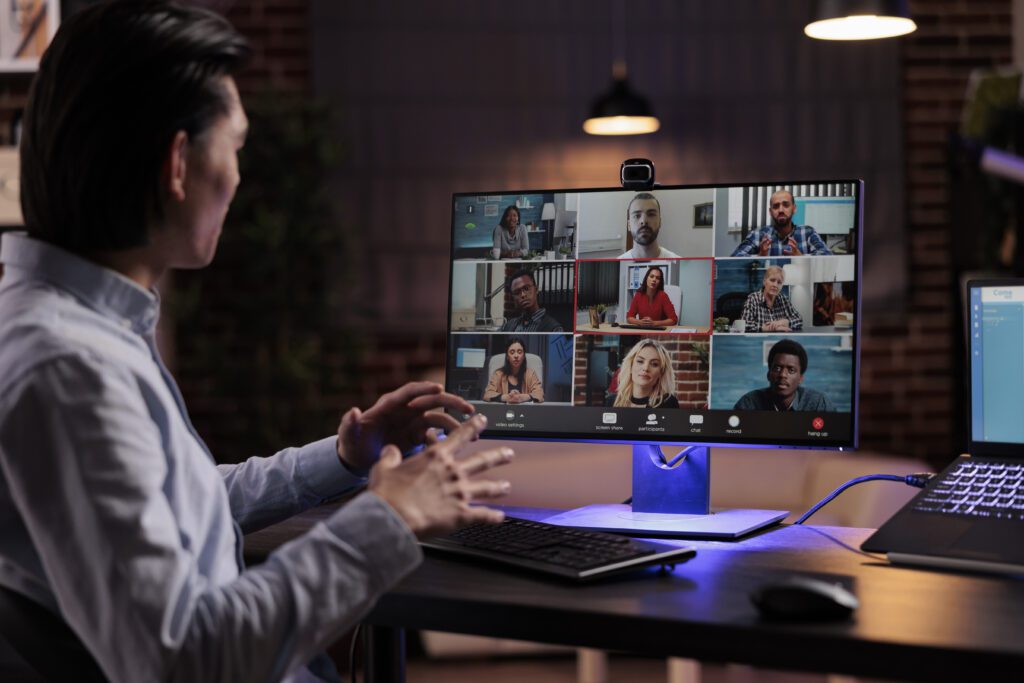The team presentation is one of the most effective ways to showcase your brand, build trust and credibility with audiences, and position your company as an industry leader. But developing a cohesive narrative and effective visuals for this type of meeting can be challenging.
Reading this blog will equip you with proven strategies to enhance B2B presentations through effective team collaboration, elevating your brand’s impact and engaging your audience for lasting success.
Here are 2 Consequences if the Team Presentation is not Engaging.
- Diminished Audience Interest: An unengaging team presentation can lead to reduced audience interest and attention. Listeners may become disinterested, distracted, or disengaged, resulting in a missed opportunity to effectively convey the message.
- Lack of Message Retention: If the team presentation fails to captivate the audience, there is a higher likelihood of poor message retention. Without engagement, listeners may struggle to remember key points, hindering the presentation’s impact and the audience’s ability to act on the information presented.
Main Causes of an Unengaging Team Presentations:
- Lack of Preparation: Inadequate preparation or coordination among team members can result in a presentation lacking a clear structure and cohesive message.
- Monotonous Delivery: Presenters with a flat or uninspiring delivery style can fail to capture the audience’s attention and enthusiasm.
- Overwhelming Text-Heavy Slides: Slides overloaded with text and lacking visual elements can overwhelm the audience and hinder information retention.
Here is How CustomShow can Help in Creating Compelling Team Presentations:
- Interactive Collaboration: CustomShow facilitates seamless team collaboration by allowing multiple users to work on the same presentation simultaneously. Team members can share feedback, make real-time edits, and ensure a cohesive and compelling final product.
- Captivating Visuals: With a wide range of customizable templates and visual elements, CustomShow enables users to create visually stunning and engaging presentations. High-quality graphics, multimedia integration, and dynamic transitions elevate the impact of team presentations.
- Data-Driven Insights: CustomShow provides analytics and data tracking features that allow users to assess audience engagement, identify areas for improvement, and refine their team presentations for maximum effectiveness.
Schedule a demo with our experts

Here are some best tips and practices to help you prepare for Team Presentations:
Leveraging Team Dynamics for Impactful Presentations
To maximize the impact of a team presentation, it’s important to understand the roles and strengths within your group. You want to be sure that everyone is clear on what they need to contribute and how their contributions will support the overall message.
This can be accomplished by holding regular meetings where each member has an opportunity to share what they’ve been working on so far, ask questions about other members’ projects and offer feedback when necessary. This will help ensure that everyone has a solid grasp on what everyone else is doing–and why it matters for the final product or service offering.
It may also be helpful for team members who are less comfortable speaking in front of groups (or simply don’t like public speaking) especially those being considered for the hire dedicated development team if you provide them with some coaching or training beforehand so they feel more comfortable delivering their piece during presentations. Along with proper training, make sure to provide new hires with smooth onboarding process and a real pay stub to ensure they have the necessary documentation for their employment records. AI apply for jobs tools can help streamline the onboarding and paperwork process, making it easier for both the employer and the employee
Crafting a Cohesive Presentation Narrative
A compelling presentation narrative is the backbone of any successful team presentation. It serves as a roadmap that guides the audience through a coherent and engaging storytelling experience. To create a cohesive presentation narrative, consider the following essential elements:
- Define Your Presentation Objective: Establish the primary goal of your team presentation. Identify the key message or main takeaway you want the audience to grasp. Having a well-defined objective helps in structuring the content and ensures that the presentation remains focused and impactful.
- Structure for Seamless Flow: Organize the presentation in a logical sequence to maintain a smooth flow of information. Start with an attention-grabbing introduction to hook the audience. Then, break down the content into distinct sections or segments, each supporting your main message. End with a strong conclusion that reinforces the key points and leaves a lasting impression.
- Utilize Storytelling Techniques: Storytelling is a powerful tool in creating an emotional connection with the audience. Weave facts, data, and information into relatable stories that resonate with the audience. Personal anecdotes, case studies, or real-life examples add authenticity and make the presentation more memorable.
- Maintain Consistency and Clarity: Ensure consistency in your presentation narrative by aligning each team member’s content with the overarching theme and message. Avoid tangents or unnecessary details that may dilute the central idea. Keep the language clear, concise, and accessible, catering to the audience’s understanding level.
- Incorporate Visual Support: Enhance the narrative with compelling visuals that complement the spoken content. Use relevant images, SVGs, infographics, and charts to reinforce key points and improve information retention. Visuals not only make the presentation more engaging but also aid in conveying complex ideas effectively.
- Engage the Audience: Integrate interactive elements, such as questions, polls, or thought-provoking statements, to keep the audience engaged throughout the presentation. Encourage participation and foster a two-way communication approach to create a sense of involvement.
Utilizing Visuals and Multimedia for Added Impact

Consider the following strategies to maximize the impact of visuals and multimedia in your team presentation:
- Incorporate Visually Appealing Slides: Design visually appealing slides that align with your brand identity and presentation theme. Use high-quality images, icons, and graphics that complement the spoken content and reinforce key messages.
- Integrate Videos and Multimedia Elements: Introducing videos, animations, or interactive elements can elevate the engagement level of your team presentation.
- Ensure Consistency in Branding: Maintain consistency in visual elements throughout the presentation to strengthen your brand identity and build brand awareness. Use consistent colors, fonts, and design elements that align with your company’s branding guidelines.
- Emphasize Data Visualization: When presenting data or statistics, utilize data visualization techniques and even consider leveraging data visualization services to make complex information more digestible. Infographics, charts, and graphs are powerful tools for presenting data in a visually engaging and easy-to-understand manner.
- Balance Visuals and Verbal Content: Strike a balance between visuals and verbal content to avoid overwhelming the audience. If the purpose of the meeting is to discuss social media campaign results, you can use a social media analytics report to guide you throughout the presentation.
- Test and Optimize Multimedia Elements: Before the presentation, test all multimedia elements to ensure they work smoothly and seamlessly.
Nurturing Audience Engagement through Interactivity

Interactive content is a great way to engage users and encourage audience participation. This can be done via live demos or case studies, which will help your audience visualize how their product or service can benefit them.
For example, if you’re presenting a new CRM tool for sales teams, consider including a demo showing how it works in action. This will allow people to experience the product firsthand rather than just reading about its features on paper or seeing screenshots on screen.
Managing Time and Transitions Effectively
Follow these essential strategies to manage time and transitions effectively in your team presentation:
- Allocate Presentation Time: Divide the total presentation time among team members according to the content they are responsible for.
- Practice Transitions: Rehearse transitions between team members’ segments to create a seamless flow. Clearly define how each presenter will hand off to the next, maintaining audience engagement and minimizing disruptions.
- Timekeeping and Reminders: Designate a timekeeper within the team to monitor the presentation’s progress. Use subtle cues or signals to remind presenters of the time remaining during their segment.
- Be Concise and Focused: Encourage team members to be concise and focused in their delivery. Avoid unnecessary repetition or excessive details that may extend the sales presentation beyond the allotted time.
- Plan for Q&A: Allocate time for a well-managed question-and-answer session. Ensure that presenters leave adequate time at the end of their segment to address any audience inquiries.
- Practice, Practice, Practice: Conduct thorough rehearsals as a team, incorporating time management and smooth transitions into the practice sessions. Practicing together fosters confidence and familiarity with the presentation’s timing.
Rehearsing and Fine-Tuning the Team Presentation
Rehearsing and fine-tuning the team presentation is a vital part of the preparation process. As you practice together, you should:
- Ensure coherence and alignment. The goal of rehearsal is to ensure that everyone on your team understands their role in the presentation and is able to deliver it in a cohesive way with other members of your group. If someone doesn’t understand something or has questions about how they’re supposed to say something, this is where you’ll want them to ask those questions so that we can get them answered before it comes time for actual presentations!
- Seek feedback from others outside your organization (e.g., peers) when possible; make necessary improvements based on their suggestions; identify areas where further research may be helpful (e
Conclusion
As you can see, there are a number of different ways to make your team presentation more impactful. The key is to find the ones that work best for your brand and use them consistently. The best way to do this is by rehearsing and fine-tuning before presenting to an audience so they’re prepared for anything!

